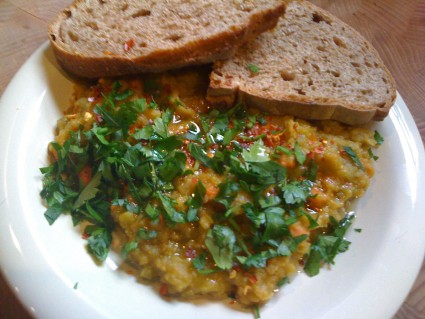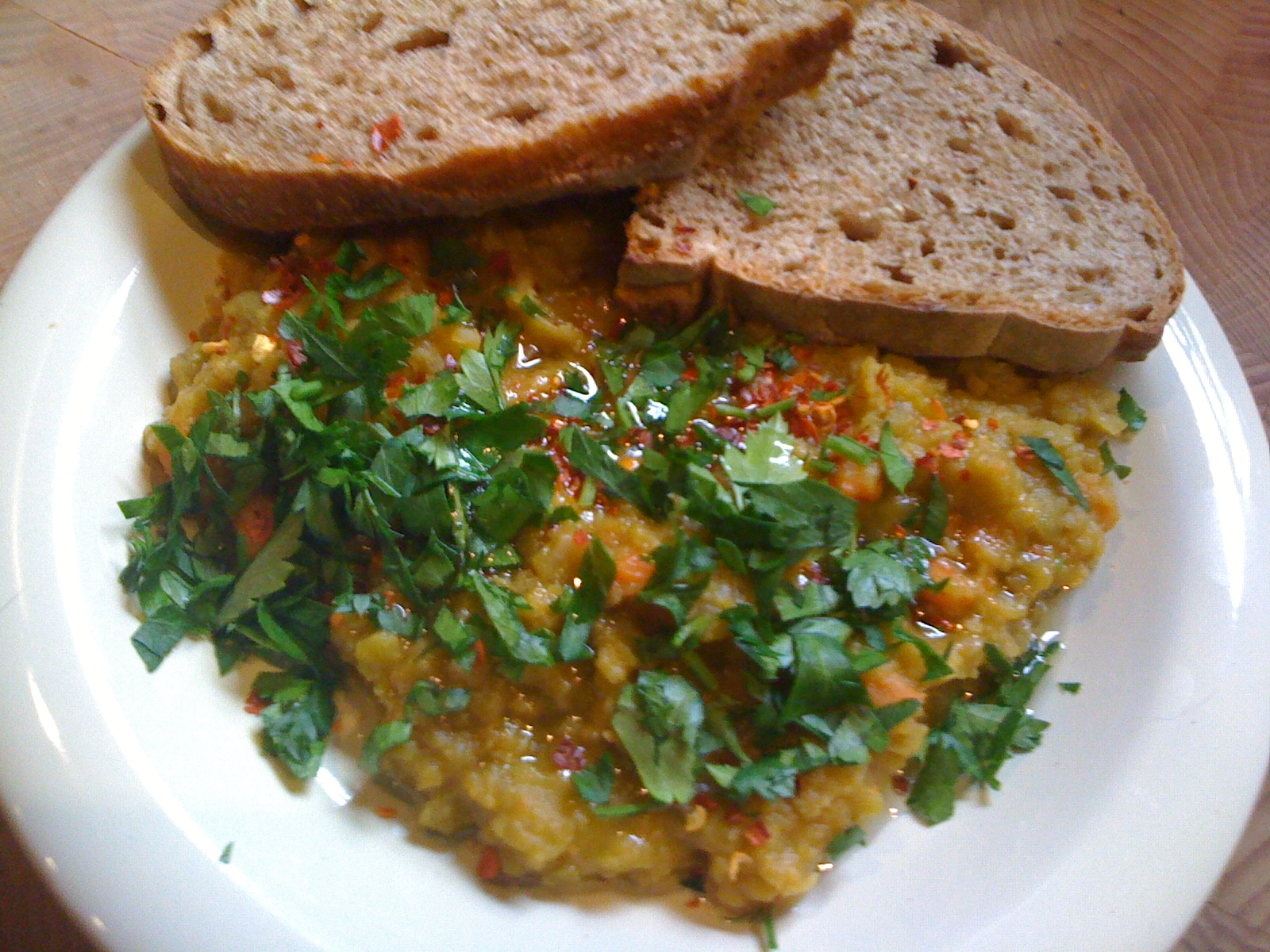In Tom’s Kitchen, Grist’s food editor discusses some of the quick-and-easy things he gets up to in, well, his kitchen. He thinks the column name sucks–please help him rename it. Email ideas to tphilpott[at]grist[dot]org. He apologizes for the lame iPhone photography.
———-
 Photo: Tom PhilpottIt’s been a rough winter up here in these North Carolina mountains. When it hasn’t been bitterly cold–day after day of sub-20 degree chill–it’s been just sort of cold but very rainy. One of my main food obsessions has been split-pea soup–one of the most warming dishes known to man.
Photo: Tom PhilpottIt’s been a rough winter up here in these North Carolina mountains. When it hasn’t been bitterly cold–day after day of sub-20 degree chill–it’s been just sort of cold but very rainy. One of my main food obsessions has been split-pea soup–one of the most warming dishes known to man.
Actually, I’ve been obsessed with split peas since having a bowl of them at Sandwhich, a fantastic lunch spot in Chapel Hill, a year or so ago. I had always thought it a dull, prosaic dish. But then I tried tried the Sandwhich version: spiced up with smoked paprika and finished with a lashing of peppery olive oil. The combination of flavors–sweetness from the peas, smoke and heat from the paprika, and richness from the oil–stopped me in my tracks.
I’ve been making it at home ever since, trying to recreate that Sandwhich magic. Since the cold settled in last month, I’ve ramped up my efforts. Split peas make a fantastic midweek dinner. Unlike other dried legumes, they cook quickly–in an hour or so. This flavorful version, served over brown rice or crusty toasted bread, is deeply satisfying.
In this column, I won’t be giving recipes per se; but describing how I cook a simple dish, with plenty of variations.
Split peas for four (easily doubled)
 Mise en place: get it together. Photo: Tom PhilpottMise en place (A French cooking term that essentially means, “getting your shit together”):
Mise en place: get it together. Photo: Tom PhilpottMise en place (A French cooking term that essentially means, “getting your shit together”):
1) 1.5 cup split peas, rinsed and picked through for rocks
2) 1 large onion, 1 large carrot, 1 large celery stalk, chopped. (This flavor-building mixture is called a mirepoix in French; it is a great thing).
3) 2-4 cloves garlic, minced. (I use four.)
4) 4.5 cups water or homemade stock.
5) Some decent extra-virgin olive oil; and the best olive oil in the house (don’t worry if you don’t have a special bottle).
6) Something spicy/smoky: 2 teaspoons of Spanish smoked paprika (pimenton de la Vera, available where good spices are sold); or 1-2 minced chipotle peppers, dried and re-hydrated in hot water or canned. Alternately, a few slices of good quality bacon (i.e., from pastured hogs) could be chopped and added to the mirepoix (number 2 above).
7) Something acidic, like a wedge of lemon or some wine vinegar.
8) Good sea salt and a pepper grinder.
9) Something green, like flat-leaf parsley or even arugula. To be chopped while peas are cooking.
10) A little crushed red chile pepper, optional but really nice.
Process:
Cover bottom of a medium heavy-bottom pot with your everyday olive oil. Turn heat to a gentle medium. After a minute, add the miroepoix vegetables (hold off on the garlic; it burns easily). Cook, stirring often, for ten or so minutes, until veggies are soft but not browned. If they threaten to turn brown, turn heat down a little. Add the garlic and the paprika or chipotles. Cook, stirring, until garlic perfumes the air, a minute or so. Note the beautiful red hue everything has turned. Add the peas, stir to mix with the veggies. Add the water or stock; bring to boil; cover; turn heat to low; let simmer.
As the beans cook, check them every few minutes. If they seem on the verge of drying out, add some hot water or stock. While they’re cooking, chop about half a bunch of parsley or a several arugula leaves for garnish. The beans should be done in about an hour, maybe a little less. They are ready when they are very soft. Their collapse should be complete, catastrophic, abject: like a Democratic Senator confronting a question of principle.
When they are done, add a vigorous twist or three of black pepper, and taste. They will taste quite flat. Stir in a teaspoon of salt, and marvel at the flavors that emerge. Now add a small amount of acid–a teaspoon or so lemon juice or vinegar. You don’t want it to taste lemony or vinegary; you just want the acid to balance the flavors. Taste again and adjust for salt, pepper, and acid. More smoked paprika could be added at this stage, if desired.
To serve, ladle into warm bowls over brown rice or toasted crusty bread. Drizzle with the best olive oil you have–this dish will showcase its flavor–add a dash of crushed chile flakes, and a good sprinkle of chopped greens.
This dish goes with malty, lightly hopped brown ales like Bell’s Best Brown; and with rustic, simple red wines. I’ve been enjoying the 2008 Vin de Pays du Vaucluse ($10), bottled for the great wine merchant Kermit Lynch.



